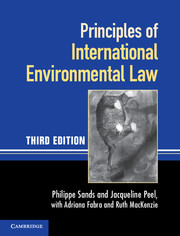Book contents
- Frontmatter
- Contents
- Foreword
- Preface and acknowledgments to the first edition
- Preface and acknowledgments to the second edition
- Preface and acknowledgments to the third edition
- Table of cases
- Table of treaties and other international instruments
- Abbreviations
- Part I The legal and institutional framework
- Part II Principles and rules establishing standards
- 6 General principles and rules
- 7 Atmospheric protection and climate change
- 8 Freshwater resources
- 9 Oceans, seas and marine living resources
- 10 Biological diversity
- 11 Hazardous substances and activities
- 12 Waste
- 13 The polar regions: Antarctica and the Arctic
- Part III Techniques for implementing international principles and rules
- Part IV Linkage of international environmental law and other areas of international law
- Index
- References
10 - Biological diversity
from Part II - Principles and rules establishing standards
Published online by Cambridge University Press: 05 June 2012
- Frontmatter
- Contents
- Foreword
- Preface and acknowledgments to the first edition
- Preface and acknowledgments to the second edition
- Preface and acknowledgments to the third edition
- Table of cases
- Table of treaties and other international instruments
- Abbreviations
- Part I The legal and institutional framework
- Part II Principles and rules establishing standards
- 6 General principles and rules
- 7 Atmospheric protection and climate change
- 8 Freshwater resources
- 9 Oceans, seas and marine living resources
- 10 Biological diversity
- 11 Hazardous substances and activities
- 12 Waste
- 13 The polar regions: Antarctica and the Arctic
- Part III Techniques for implementing international principles and rules
- Part IV Linkage of international environmental law and other areas of international law
- Index
- References
Summary
INTRODUCTION
The term ‘biodiversity’ is of relatively recent usage in international law. Until the 1980s, international instruments tended to address ‘wildlife’ or ‘wild fauna and flora’, and focused on species and habitats. ‘Biodiversity’ is a more inclusive term and can be considered in relation to three hierarchical categories which describe different aspects of living systems measured in different ways: genetic diversity; species diversity; and ecosystem diversity. Other expressions of biodiversity include the relative abundance of species, the age structure of populations, the pattern of communities in a region, and changes in community composition and structure over time.
However measured, there is a scientific consensus that biodiversity is being lost. In 2002, the parties to the 1992 Convention on Biological Diversity adopted the 2010 Biodiversity Target ‘to achieve by 2010 a significant reduction of the current rate of biodiversity loss at the global, regional and national level as a contribution to poverty alleviation and to the benefit of all life on Earth’. In 2010, it was acknowledged that this target had not been met, that the state of biodiversity continued to decline and that pressures on biodiversity were increasing. The 2010 Global Biodiversity Outlook (GBO) suggests that just under 130,000 square kilometres of forest were converted to other uses or were lost through natural causes each year from 2000 to 2010. It records that more than 95 per cent of North American grasslands have been lost, and that savanna and grassland have suffered severe declines elsewhere. The GBO also notes that terrestrial habitats have become highly fragmented, threatening the viability of many species and ecosystem services. The Millennium Ecosystem Assessment reports that about 20 per cent of the world's coral reefs have been destroyed and another 20 per cent degraded. In relation to species populations, the GBO suggests that the population of wild vertebrate species fell by an average of 31 per cent globally between 1970 and 2006, with particularly severe declines in the tropics and in freshwater ecosystems. The IUCN Red List, which evaluates the conservation status of animal and plant species, had, by 2009, assessed 47,677 species, of which 36 per cent were considered threatened with extinction.
- Type
- Chapter
- Information
- Principles of International Environmental Law , pp. 449 - 513Publisher: Cambridge University PressPrint publication year: 2012



